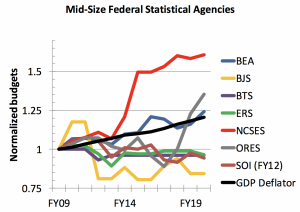How (In)Visible Is Science in ASA?
John Gardenier
Read ASA Science Policy Director Steve Pierson’s response to Gardenier’s points.
A feature article on the FY 20/21 budgets in the April 2020 issue of Amstat News addressed the impact on selected statistical agencies. On the plus side, it contained a lot of relevant tabular data that is readily readable but, like tabular data generally, is not as readily interpretable. An excellent start to making the implicit messages understandable came in two well-designed graphs with brightly colored, easily distinguishable plot lines, well-formulated and labeled axes, and clear labels.

Figure 1: The budgets of the seven mid-sized statistical agencies normalized to their FY09 levels, along with the GDP deflator to account for inflation. Budget restructuring for ERS in FY15 and ORES in FY19 are accounted for in the graph to allow for comparison. [Key: BEA, Bureau of Economic Analysis; BJS, Bureau of Justice Statistics; BTS, Bureau of Transportation Statistics; ERS, USDA Economic Research Service; NCSES, NSF National Center for Science and Engineering Statistics; ORES, Social Security Administration Office of Research, Evaluation, and Statistics; SOI, IRS Statistics of Income Division ]
Figure 1 practically shouts the message of a very dramatic increase of interest in data on the scientific enterprise writ large. It would appear that such a message is of virtually no interest to ASA statisticians. Not only is NCSES not defined in the legend to the graph, but unlike the rest of the alphabet soup, it is not even spelled out in the text.
As a relatively new (2012) and mid-sized federal statistical agency, the National Center for Science and Engineering Statistics is not as widely known as most others. Still, its data do impact the most dramatic issues/threats facing the nation and the world. Those prominently include COVID-19 and global climate change, as well as other matters facing humanity throughout this century and beyond. They also may impact less dramatic issues of broad applicability to humanity and life in general, as well as issues that are vital to limited geographies and communities. There is a virtually unlimited range of vastly interesting, highly productive, and well-compensated work for statisticians out there.
The article quite rightly leaves a general, more complete, and more detailed analysis of these data to more intensive and technical research media. That does not justify Amstat News ignoring one of the clearest and most relevant messages in the data as an example of why this and similar matters deserve much more analysis and reporting elsewhere. They also can impact members of the profession.
Apart from this one article, there is in ASA current interest and study of the general issue of inter-silo communication among the various sciences generally, importantly including statistics. In general, this problem could be aided by Amstat News and similar internally addressed media within many and varied scientific and engineering associations and institutions.
ASA should encourage interested scientists generally and their organizations to contribute to Amstat News brief articles describing the critical importance of statistical inclusion in collaborative scientific and engineering research. They should address the benefits achieved in specific instances, the difficulties overcome, and suggestions for ways to further improve such collaborations going forward.
ASA should also encourage statisticians who are engaged in interdisciplinary endeavors—and their colleagues—to seek opportunities to contribute similarly themed communications to the relevant internal media. In doing so, as appropriate, they should emphasize the many areas of agreement on technical and methodical issues they see within our discipline while being willing to admit that there also exist a variety of opinions on many specific statistical matters. In each case, they should distinguish generally held positions from personal or institutional positions that may be important but less generally accepted. This latter note of caution applies to all disciplines and many institutions, of course.

















